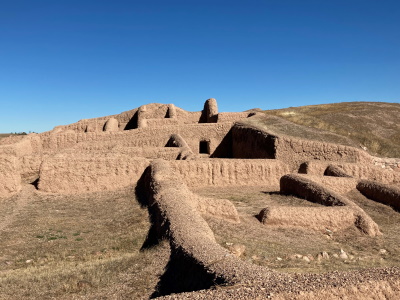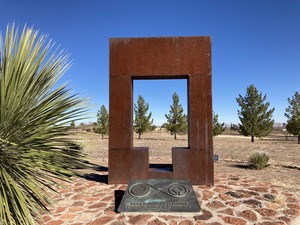Paquimé

The Archeological Zone of Paquimé, Casas Grandes is an archaeological site of a settlement of the Pueblo culture.
The remains show the connection between the adobe architecture of the Southwestern United States and the more complex structures of Central American cultures. Paquimé developed between 1200 and 1400 into an important commercial center with about 10,000 inhabitants. It had a complex water control system.
Community Perspective: Easier to visit on a US road trip (see Randi’s description) than from Central Mexico (Els did so via Chihuahua by public transport, Clyde with a car from Hermosillo). It lacks grand monuments, but it is an interesting and calm place with a good on-site museum.

Map of Paquimé
Community Reviews
Clyde

I visited this WHS in spring 2024. I drove to Nuevo Casas Grandes from Hermosillo airport (8 hrs) and apart from a few military checkpoints along the highway where the Trump wall is visible, the only minor issue were the many potholes. If you happen to have a rental car with hub caps, I suggest removing them or buying straps as otherwise you'll most certainly lose them while driving to/from Paquimé. Keep in mind that it can get very cold after sunset and especially in the morning with the formation of morning dew; but after that it quickly gets very hot.
The ancient city of Paquimé is located just 60 miles south of the US border in a fertile valley of the Casas Grandes or San Miguel River in the northern part of the Mexican state of Chihuahua. The archaeological zone of the city covers about 370 acres thus making it the largest that represents the peoples and cultures of the Chihuahua Desert. Paquimé is said to contain the most monumental and complex architecture in all of northern Mexico. It is quite possible that Paquimé has been influenced by Chaco Canyon and the peoples of the Four Corners region, as evidenced in some of the construction methods used at the city, such as T-shaped doors and the facades with porticoes.
In addition to the mud-and-gravel brick 4 storey apartments, in Paquimé one can find great plazas and public spaces, a complex irrigation and sewage system, ball courts built in the style of the Mesoamerican ball game, community fire pits, a solar observatory, elite burial mounds, and a peculiar complex in the center of the city where tropical birds from southern Mexico were bred for commercial and ritualistic purposes, the most important bird being the scarlet macaw. Paquimé also had a booming crafts industry as evidenced by the many workshops uncovered at the site and the pottery and jewellery found there, most of which can be appreciated in the Cultural Centre of Paquimé (the UNESCO WHS plaque lies in the roundabout near its parking lot) and in the Museo Nacional de Antropología in Mexico City.
I really enjoyed my loop around the site, even though the information boards present don't provide in-depth information. I hope to be able to visit the similar sites in the US in the future, to be able to compare the similarities and differences, and hopefully learn more about these lost ancient cities.
Els Slots

Paquimé, located over 1,700 km north of Mexico City, is a site that is often overlooked. It doesn’t have the great monuments that other pre-Columbian Mexican sites are known for. It’s a niche site for archaeologists, exemplifying architectural and trading links between the area of the Classic Pueblo sites (now located in the Southwest USA) and Mesoamerica. Research has never been intensive, as archaeologists traditionally focus on either one of these worlds. But I was pleasantly surprised by its size and good condition. For me, it closed a circle after having already seen the other Puebloan sites of Mesa Verde, Taos, and Chaco. A visit also brings a lot of insight into the specific history of this region, always so far away from everything.
After walking past the still closed entrance barrier at the opening hour of 10 a.m., I was welcomed in by the guard and his German shepherd dog (I kept a safe distance, much more than 1.5m!) and sent on my way to walk the circuit that is signposted at the site. The first structure one encounters here is the ball court – it looks like a simpler version of the Mayan ones. The presence of a Mesoamerican ballcourt at Paquimé is often given as an example of the fusion of cultures that happened here, but the northern cultures had their own kind of ball courts as well and we do not even know whether they all played the same game.
The settlement consisted of several large residential compounds inhabited by family clans. In between them, structures for public use can be found, such as large ovens in which agave was turned into an alcoholic drink, irrigation canals, and places for religious ceremonies.
While preparing for my visit, I was most intrigued by the presence of bird pens for macaws. Although these birds are not found naturally in this desert area, they were kept and bred here. Their colourful feathers were used locally for religious rituals; the birds and feathers were also part of a lucrative trade with other settlements. Hundreds of bird skeletons have been found. On-site, a drawing shows how these bird pens were used: they used to have coverings and the birds were taken in and out via removing the plug at the front. The compound at the House of the Macaws even had special basins where they had their feathers removed.
The site in general looks well-looked after. The on-site museum is said to be excellent, however, this was closed when I visited in January 2022 due to maintenance reasons (this was not mentioned on their website, but my B&B owner had warned me). There is a fixed and signposted itinerary around the site that you have to follow. All along the route, there are information panels with texts in Spanish and English, adding to my knowledge even though I had read up well beforehand (see the links section for suggestions). It brought to light a few new connections, such as the astrological use of certain platforms and the clever canal system.
The visitor experience could be improved though: it is logical that you are not allowed to climb on the adobe walls of the buildings, but also you may not enter any of them. As all buildings are surrounded by earthen walls, it is hard to get a good look at the more interesting things inside the compounds. It would benefit from a couple of low viewing platforms like you see at Ancient Roman sites to be able to better view mosaics.
Getting there on public transport: best is to fly into the state of Chihuahua, to either Chihuahua or Ciudad Juarez. The city after which the dog species is named appealed to me more than the one associated with femicide. From Chihuahua, there are about 8 buses a day to Nuevo Casas Grandes. Both Omnibus de Mexico and Chihuahenses service this route, the bus I took continued to Nogales at the US border. Prebooking your ticket a day before (online, from a Mexican IP address) is advised. The ride takes about 4 hours. From Nuevo Casas Grandes it’s another 7km to Pueblo Viejo, the village where Paquimé is located. Taxis are available to cover this last stretch, as is an hourly yellow school bus.
Read more from Els Slots here.
Randi Thomsen

On our US road trip in may 2018, we spent a day going south to visit Paquime. From Tucson we crossed the border at Aqua Prieta and we had no trouble crossing the border. We bought Mexican car insurance from Thrifty, one of the few car rentals that allow driving into Mexico. We had very few expectations to the Mexican road trip but were really surprised. The first 100 km along the US boarder was very scenic, with mostly good roads.
Paquime was very calm. On a Saturday there were a few other Mexican tourists around, but “none” foreign. Paquime is largest pre-columbian site in North America. The visitor center was informative and explained well the city and people living there, and had a small, but nice exhibition of pottery and figurines. The people of Paquime were excellent craftsmen. The city was established in 1100 century by people coming from north. The citys construction was made up of innovative adobe techniques. They built multi-familiar complexes, some of them counting four floors and more than 1700 rooms. That’s why the Spaniards called the place Casas Grandes. It was called Paquime by the natives who lived there for about 300 years. The multi-family complexes and the T-shaped doorways is significant to the city. Later we also found traces of those doorways in Chaco Canyon, but not to the same extend.
There were also open plazas for markets, ceremonial structures, mounds with architectural features in the form of decapitated birds, ball courts in meso-american style and astronomical functions. The success of the city is observable in how they controlled water. They build hydraulic systems from the mountains of Sierra Madre to the valley used to provide the city with water and to irrigate its fields. Water was distributed through dikes, irrigation canals and ditches. It was cisterns contained drinking water for the people. Drainage systems were built to avoid flooding. They also had a canal system to distribute water into the houses for domestic use.
There were many similarities to what we later saw in Chaco Culture and Mesa Verde like the Kivas and the odd T shaped doors.
Paquime is not the grandest of archeological sites in Mexico, but an interesting visit.
On our way back, we crossed the border at Puerto Palomas into New Mexico south of Columbus. Except for half an hour wait we had no troubles going back to the US.
P.S We later found out that the area, Chihuahua, is not safe to travel in do to narco-wars. There have been incidents of killings, including tourist, but we didn’t encounter anything scary and felt safe.
Ivan Cardenas
Paquime is a great place to visit, it is not that far from the border with Texas and New Mexico. You can even visit it for a weekend getaway. The museum is excelent, and it is not expensive. While in the area, you can choose from various hotels and good restaurants. For all of you guys who always have to be checking your e-mails, you can visit "El Cybernetico" an internet cafe in Nuevo Casas Grandes.
Kelly Henry
Casas Grandes is a 50 mile drive south of the New Mexico, USA border into Chihuahua, Mexico on a good highway. The adobe or mud city is partially restored and provides a good example of how the pueblo native americans settled down. The adjoining museum is excellent. Nuevo Casas Grandes is just 15km down the road with great restaurants and motels. Also, you don't need to speak Spanish to get there. Like other pueblo indian sites, the dwellings are apartment style buildings with everyone living in close quarters.
Community Rating
Site Info
- Full Name
- Archeological Zone of Paquimé, Casas Grandes
- Unesco ID
- 560
- Country
- Mexico
- Inscribed
- 1998
- Type
- Cultural
- Criteria
-
3 4
- Categories
- Archaeological site - Pre-Columbian
- Link
- By ID
Site History
1998 Inscribed
1991 Referred
Bureau -pending the results of a comparative study of property of this type located in Mexico and the United States.
Site Links
Unesco Website
Official Website
Related
Connections
The site has 12 connections
Art and Architecture
Constructions
History
Human Activity
Science and Technology
Timeline
Visiting conditions
World Heritage Process
Visitors
22 Community Members have visited.
The Plaque
 (photo by Els)
(photo by Els)